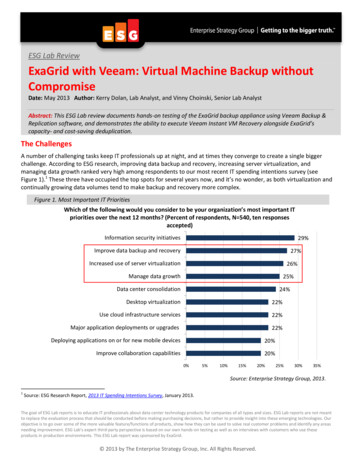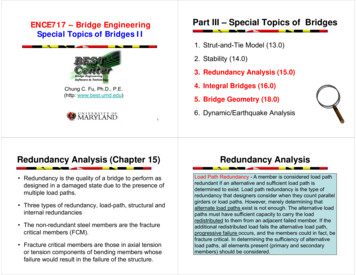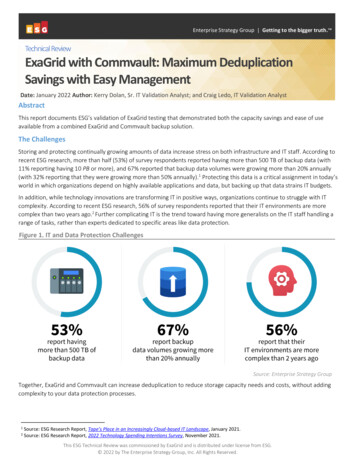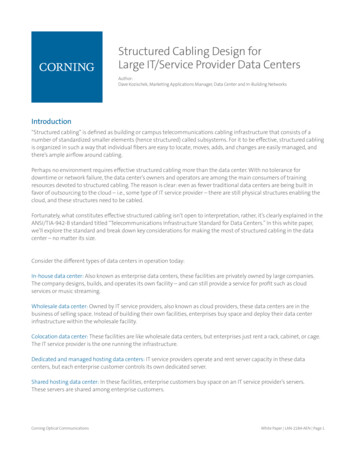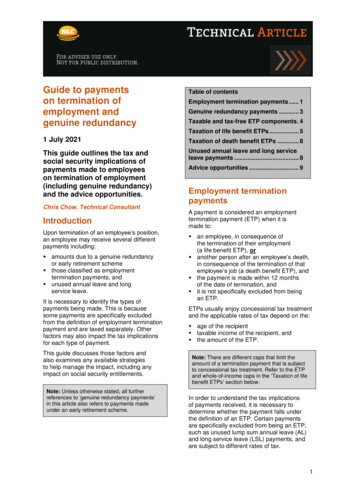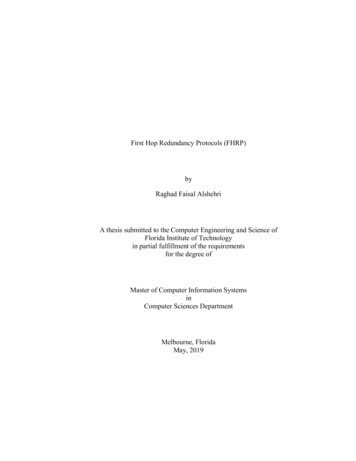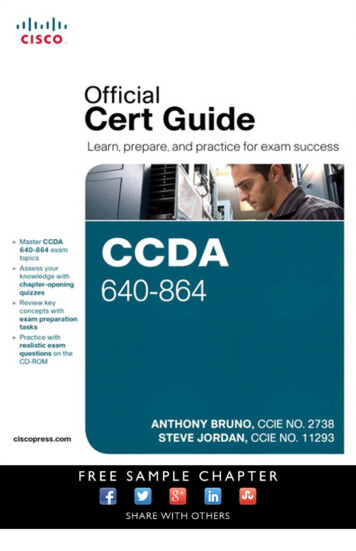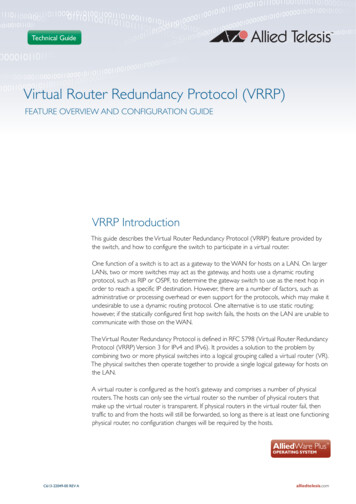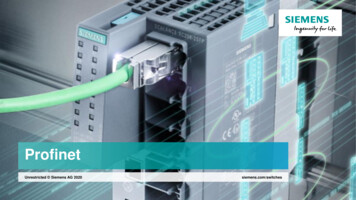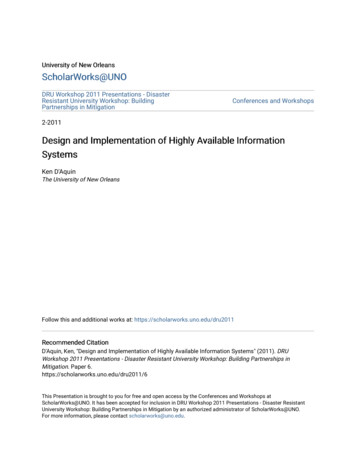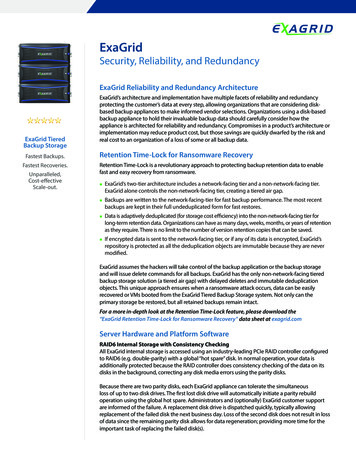
Transcription
ExaGridSecurity, Reliability, and RedundancyExaGrid Reliability and Redundancy ArchitectureExaGrid TieredBackup StorageFastest Backups.Fastest aGrid’s architecture and implementation have multiple facets of reliability and redundancyprotecting the customer’s data at every step, allowing organizations that are considering diskbased backup appliances to make informed vendor selections. Organizations using a disk-basedbackup appliance to hold their invaluable backup data should carefully consider how theappliance is architected for reliability and redundancy. Compromises in a product’s architecture orimplementation may reduce product cost, but those savings are quickly dwarfed by the risk andreal cost to an organization of a loss of some or all backup data.Retention Time-Lock for Ransomware RecoveryRetention Time-Lock is a revolutionary approach to protecting backup retention data to enablefast and easy recovery from ransomware. ExaGrid’s two-tier architecture includes a network-facing tier and a non-network-facing tier.ExaGrid alone controls the non-network-facing tier, creating a tiered air gap.Backups are written to the network-facing-tier for fast backup performance. The most recentbackups are kept in their full undeduplicated form for fast restores.Data is adaptively deduplicated (for storage cost efficiency) into the non-network-facing tier forlong-term retention data. Organizations can have as many days, weeks, months, or years of retentionas they require. There is no limit to the number of version retention copies that can be saved.If encrypted data is sent to the network-facing tier, or if any of its data is encrypted, ExaGrid’srepository is protected as all the deduplication objects are immutable because they are nevermodified.ExaGrid assumes the hackers will take control of the backup application or the backup storageand will issue delete commands for all backups. ExaGrid has the only non-network-facing tieredbackup storage solution (a tiered air gap) with delayed deletes and immutable deduplicationobjects. This unique approach ensures when a ransomware attack occurs, data can be easilyrecovered or VMs booted from the ExaGrid Tiered Backup Storage system. Not only can theprimary storage be restored, but all retained backups remain intact.For a more in-depth look at the Retention Time-Lock feature, please download the“ExaGrid Retention Time-Lock for Ransomware Recovery” data sheet at exagrid.comServer Hardware and Platform SoftwareRAID6 Internal Storage with Consistency CheckingAll ExaGrid internal storage is accessed using an industry-leading PCIe RAID controller configuredto RAID6 (e.g. double-parity) with a global “hot spare” disk. In normal operation, your data isadditionally protected because the RAID controller does consistency checking of the data on itsdisks in the background, correcting any disk media errors using the parity disks.Because there are two parity disks, each ExaGrid appliance can tolerate the simultaneousloss of up to two disk drives. The first lost disk drive will automatically initiate a parity rebuildoperation using the global hot spare. Administrators and (optionally) ExaGrid customer supportare informed of the failure. A replacement disk drive is dispatched quickly, typically allowingreplacement of the failed disk the next business day. Loss of the second disk does not result in lossof data since the remaining parity disk allows for data regeneration; providing more time for theimportant task of replacing the failed disk(s).
Flash-Backed RAID CacheThe industry-leading PCIe RAID controller has an onboard volatile memory writeback cache that is backed up to flash memorywhen system power is lost or interrupted. The RAID controller’s super-capacitor provides ample power to allow all writebackcache data to be transferred to flash until system power is restored.Redundant Power SuppliesAll ExaGrid models include redundant power supplies monitored by the system software, producing an alert and optionallyan e-mail notification of any power supply issues. When Health Monitoring (see below) is enabled, ExaGrid customer supportis made aware of the issue and can immediately arrange for the shipment of replacement power supply. Power supplies, likedisk drives, are hot-swappable.Securing Data on the WANReplication of deduplicated backup data can be encrypted when transferred between ExaGrid sites using 256-bit AES, whichis a FIPS PUB 140-2 Approved Security Function. This eliminates the need for a VPN to perform encryption across the WAN.Encryption at Rest and Optional Boot Time SecurityExaGrid offers FIPS 140-2 Validated hardware-based disk encryption on all SEC models. Self-encrypting hard disks with RAIDcontroller-based key management and access control secures your data during the storage process. Optional boot protectionis also supported on all SEC models, requiring entry of a password on the system console during system boot. This separatepassword is used to decrypt the drive‘s data, so if this password is not known, then the server will not boot.ExaGrid Specificationsy Uses FIPS 140-2 Validated Self-Encrypting Drives (SEDs) to ensure that data at rest is always efficiently encrypted with256-bit AES and is never in the clear on the disk storage. All data, configuration settings, etc. are encrypted.y Drive theft protection – The drives cannot be read outside of the host system where encryption was enabled.y System theft protection – System booting and access to data can be restricted with a password. This can be enabled asan option (no extra charge).yOperating System PatchesCurrent ExaGrid server platform software is based on the CentOS Linux distribution. We release critical and relevant OSsecurity patches as a part our regular ExaGrid software releases. Relevant CVEs will be included at least quarterly, with criticalfixes included more quickly.ExaGrid SoftwareManagement Interfacesy ExaGrid software is managed through a web interface and will, by default, accept connections from a webbrowser on both ports 80 (HTTP) and 443 (HTTPS). ExaGrid software supports disabling HTTP for environmentsthat require HTTPS (secure) only. When using HTTPS, ExaGrid’s certificate can be added to web browsers, or auser’s certificates can be installed onto ExaGrid servers via the the web interface or provided by a SCEP server.y Windows Active Directory (AD) domain credentials can be used to control access to the ExaGrid managementinterface, providing authentication and authorization to the web GUI.y Two-factor Authentication (2FA) can be required for any user (local or Active Directory) using any industrystandard OAUTH-TOTP application.y Role-Based Access Control using local or Active Directory credentials.y Backup operator role for day-to-day operations has limitations such as no deletion of sharesy Admin role is like Linux super-user – allowed to do any administrative operation – limited users given this roley Security Officer role required to approve any changes to the Retention Time-Lock policyy Automatic user interface logout after a period of inactivity.y Although access via SSH is not necessary for user functions, some support operations can only be providedover SSH. ExaGrid secures SSH by allowing it to be disabled, allowing access via randomly generatedpasswords, or customer-supplied passwords, or only SSH key pairs.y Security checklist for quick and easy implementation of best practices.y Each ExaGrid server runs a proper firewall and a customized Linux distribution that opens just the ports andruns just the services necessary for receiving backups, web-based GUI, and ExaGrid-to-ExaGrid replication.
Share AccessyyyyyCommon Internet File System (CIFS) – SMBv2, SMBv3Network File System (NFS) – Versions 3 and 4Veeam Data Mover – SSH for command and control and Veeam-specific protocol for data movement over TCPVeritas OpenStorage Technology protocol (OST) – ExaGrid specific protocol over TCPOracle RMAN channels using CIFS or NFSFor CIFS and Veeam Data Mover, AD integration allows using domain credentials for share and management GUI accesscontrol (authentication and authorization). For CIFS, additional access control is provided via an IP whitelist. For NFS, and OSTprotocols, access control to backup data is controlled by an IP whitelist. For each share, at least one IP address/mask pair isprovided, with either multiple pairs or subnet mask used to broaden access. It is recommended that only the backup serversthat regularly access a share are placed in a share’s IP whitelist.For Veeam shares using the Veeam Data Mover, access control is provided by username and password credentials entered intoboth the Veeam and ExaGrid configuration. These can be AD credentials, or local users configured on the ExaGrid site. TheVeeam Data Mover is automatically installed from the Veeam server onto the ExaGrid server over SSH. The Veeam Data Moverruns in an isolated environment on the ExaGrid server which limits system access, has no root privileges, and runs only whenactivated by Veeam operations.Backup Data Checksums with Automatic RepairAs backup data is deduplicated, checksums are added to the deduplicated data as it is placed into the portion of the ExaGridstorage referred to as the repository. These end-to-end checksums cover the deduplicated backup data itself, and are usedto verify the backup data during processing and as it is read from disk. The deduplicated backup data can optionally bereplicated to a remote site; these checksums are used to validate the replicated data as well. During backup restore operationson shares that have been replicated to a DR site, the rare case of an invalid checksum is automatically handled by using thededuplicated data kept at the DR site.External syslogging and SNMPExaGrid software can be configured to send operational information to an external syslog receiver and/or SNMP server forfurther integration into enterprise management systems. Examples of operational information sent to a syslog receiverinclude web access audits, configuration audits, hardware issues, significant software events, etc.Deduplicated Metadata Transactional ConsistencyMetadata that tracks all of the deduplicated data is kept in a database and on internal storage. Software techniques areused to ensure transactional integrity of all metadata changes, including flushing filesystem pages into the flash-backedRAID controller’s onboard cache. The data flow of deduplicated backup data is protected end-to-end by the combination ofchecksums (above) and metadata transactional consistency.Logging FilesystemBackup data is kept in the ExaGrid internal storage on an industry-standard logging filesystem where file activity is logged forintegrity and quick repair after an unclean shutdown.Internal Database Backups and Self-Describing MetadataThe database used to keep metadata that tracks deduplicated data is periodically dumped to internal storage. Thesedumps are used to quickly restore the metadata database in the case of massive failure. The database dumps are used as anoptimization; the metadata kept on disk is self-describing and can be used to completely rebuild the deduplicated data in theinternal repository both at the local and remote ExaGrid sites.
Replication and Inter-server SecurityReplication of deduplicated backup data from one site to another can be optionally encrypted using internally-managed keys.The ExaGrid software uses a combination of Kerberos, TLS and SSH with 256-bit AES keys, which is a FIPS PUB 140-2 ApprovedSecurity Function, to secure all communications between ExaGrid servers in a site. A unique Kerberos domain is configuredper site, and all sites have trust relationships automatically configured and enforced between them. All API communicationsare authenticated using Kerberos to ensure that commands and data cannot be tampered with while traversing the network.Insulation from RansomwareWhen ransomware strikes, it is critical to have backups insulated from the malicious encryption/damage since they maybe your last line of defense. In addition to ExaGrid’s Retention Time-Lock (see above), ExaGrid helps insulate backups fromransomware in the following ways:y Comprehensive access securityy ExaGrid shares can be accessed only from designated backup/media servers. While those servers may also besubject to rampant ransomware, the fewer servers that have access to your backups, the better. If those servers areaffected by ransomware, ExaGrid’s Retention Time-Lock will allow full recovery of any and all retained backups.y Windows Active Directory domain credentials can be used to control access to ExaGrid shares (CIFS and VeeamData Mover) and management GUI, requiring Windows account credentials to be authenticated and authorizedbefore access is granted to an ExaGrid share, further reducing the chance of malicious access to backups.y Veeam Accelerated Data Mover shares require a separate Veeam password and are accessible only via SSH, withoptional key pairs, which also reduces the chance of malicious access to Veeam backups.y All accounts used to manage the ExaGrid software are protected using non-default passwords. This includes thebackup “admin” account, the special ExaGrid customer support account, and root access.y ExaGrid software is updated at least quarterly with the latest appropriate CVE fixes, reducing the ways ransomware cangain access to ExaGrid servers. Software may be updated more frequently as dictated by CVE severity.y Each ExaGrid server runs a proper firewall and a customized Linux distribution that opens just the ports and runs justthe services necessary for receiving backups, web-based GUI, and ExaGrid-to-ExaGrid replication.y Communications between ExaGrid servers is secured using Kerberos authorization and authentication, protecting froma “man in the middle” attack from malicious users or software.Periodic Assessments Using a Network Vulnerability ScannerA complete vulnerability assessment is run periodically against ExaGrid’s software. Vulnerabilities flagged by this assessmentare evaluated and tracked and mitigated as appropriate.Windows Active DirectoryExaGrid’s support for Windows Active Directory allows:y Authentication and authorization of the ExaGrid Web GUI using Active Directory user accounts and/or groups.y Authentication and authorization of ExaGrid CIFS shares using Active Directory user accounts and/or groups.y Authentication and authorization of ExaGrid Veeam shares using Active Directory user accounts and/or groups.y Access to all ExaGrid shares can continue to be controlled via an IP “whitelist.”
Key behaviors include:y Active Directory membership of ExaGrid Server(s) is defined and performed at the ExaGrid Site level. No needto configure each and every ExaGrid Server individually.y Each ExaGrid Site can be joined to only a single Active Directory Domain (just like Windows computers).y All ExaGrid Servers in a multi-server ExaGrid Site must join and belong to the same Active Directory Domain.y Different ExaGrid Sites in a multi-site ExaGrid System can be joined to different Active Directory Domains.y Once an ExaGrid Site is added to a domain, AD user(s) and/or groups – from any trusted AD Domain – aremapped to ExaGrid management role(s) for the Web GUI – e.g. administrator, backup operator, view only, etc.This mapping is done in the ExaGrid Web GUI. Any user can then login to the ExaGrid Web GUI with their ADaccount/password and will only be able to perform the management actions permitted by their assigned role– a.k.a. Role-Based Access Control (RBAC).y Once an ExaGrid Site is added to a domain, AD user(s) and/or group(s) – from any trusted AD Domain - can beused to control access to the CIFS and/or Veeam shares in that Site. The AD user/group/password is generallyconfigured into the backup application which then presents those credentials to ExaGrid when accessingshare(s).y If an ExaGrid Site is not in an Active Directory Domain, then a locally-managed set of “local users” can be usedto control access to the ExaGrid user interface and shares, including allowing “guest” access to shares.y Microsoft supports a wide range of characters in Active Directory usernames and passwords. HoweverExaGrid’s user interface login is currently limited to: Active Directory usernames and passwords that containany printable, 7-bit ASCII character including special characters and spaces.ExaGrid Support FacilitiesHealth MonitoringExaGrid servers deliver data to ExaGrid Support (phone home) using both health reporting and alerting. Health reportingincludes statistics data for trending on a daily basis and automated analysis. Data is stored on secure ExaGrid servers withtrending databases used to determine the overall health over time. Health reports are sent to ExaGrid using FTP by default,but can be sent using e-mail with some decrease in the depth of analysis. Alerts are momentary notification that couldindicate actionable events, including hardware failures, communications issues, potential misconfiguration, etc. ExaGridSupport promptly receives these alerts via e-mail from ExaGrid Support servers.Secure Remote Support AccessExaGrid Support provides a secure remote access solution so customer support engineers can provide unattendedmonitoring and corrective action on customer ExaGrid servers. Using a secure outbound TLS connection, tunnels areconnected back into ExaGrid servers. The tunnels are secured using the highest security ECDHE and AES cipher suites, usecertificate pinning for authentication, and can utilize an HTTP proxy.United StatesUnited KingdomSingapore350 Campus Drive / Marlborough, MA 01752 / (800) 868-6985200 Brook Drive / Green Park, Reading, Berkshire RG2 6UB / 44 (0) 1189 497 0511 Raffles Place, #20-61 / One Raffles Place Tower 2 / 048616 / 65 6808 5574ExaGrid reserves the right to change specifications or other product information without notice. ExaGrid and the ExaGrid logo are trademarksof ExaGrid Systems, Inc. All other trademarks are the property of their respective holders. 2021 ExaGrid Systems, Inc. All rights reserved.exagrid.com
This eliminates the need for a VPN to perform encryption across the WAN. Encryption at Rest and Optional Boot Time Security ExaGrid offers FIPS 140-2 Validated hardware-based disk encryption on all SEC models. Self-encrypting hard disks with RAID controller-based key management and access control secures your data during the storage process.
